Project > AND Gate 1 > AND Gate Result
AND Gates of Shan Shen
This AND Gate family is made of luxP-supD & pLac-T7ptag.
The typical pattern of this AND gate is like this: (picture from K228119)
This AND gate family is the earliest construction by us, and it made us much more confident about other AND Gates which were under construction at that time.
There are nine AND gates in this family, and they are distinguished by the RBS of the T7ptag gene, while sharing the same promoters to drive T7ptag and SupD. They are , , , , , , , , and . And these AND Gates are on the plasmid backbone pSB4K5, which is low copy (about 5 copies) plasmid thus it facilitates further assembling.
In order to test the function of these AND gates, Shan Shen constructed a reporter GFP under the control of a T7 promoter, which will be activated if the T7 polymerase is successfully translated.(). And the reporter is on the plasmid .
The two plasmids are sequentially transformed to E.coli, a gradient of HSL and a gradient of IPTG is combined to test the behavior of the AND Gate under different combination of HSL and IPTG concentration. The result is read by a microplate reader. Data are processed and ploted using Matlab. (Fig 1, 2, 3 and 4. For more detail, refer to our protocol)
 Fig1. GFP expression of AND gate, K228125: lux-SupD-lac-T7ptag (rbs: J44001). The data are showed for (left to right): 1×10^-9, 1×10^-8, 1×10^-7, 1×10^-6, 1×10^-5 1×10^-4 and 1×10^-3M IPTG, and (bottom to top) 1×10^-9, 1×10^-8, 1×10^-7, 1×10^-6, 1×10^-5 and 1×10^-4M HSL.  Fig2. GFP expression of AND gate, K228124: lux-SupD-lac-T7ptag (rbs: J61127). The data are showed for (left to right): 1×10^-9, 1×10^-8, 1×10^-7, 1×10^-6, 1×10^-5 1×10^-4 and 1×10^-3M IPTG, and (bottom to top) 1×10^-9, 1×10^-8, 1×10^-7, 1×10^-6, 1×10^-5 and 1×10^-4M HSL.  Fig3. GFP expression of AND gate, K228120: lux-SupD-lac-T7ptag (rbs: B0032). The data are showed for (left to right): 1×10^-9, 1×10^-8, 1×10^-7, 1×10^-6, 1×10^-5 1×10^-4 and 1×10^-3M IPTG, and (bottom to top) 1×10^-8, 1×10^-7, 1×10^-6, 1×10^-5 and 1×10^-4M HSL. 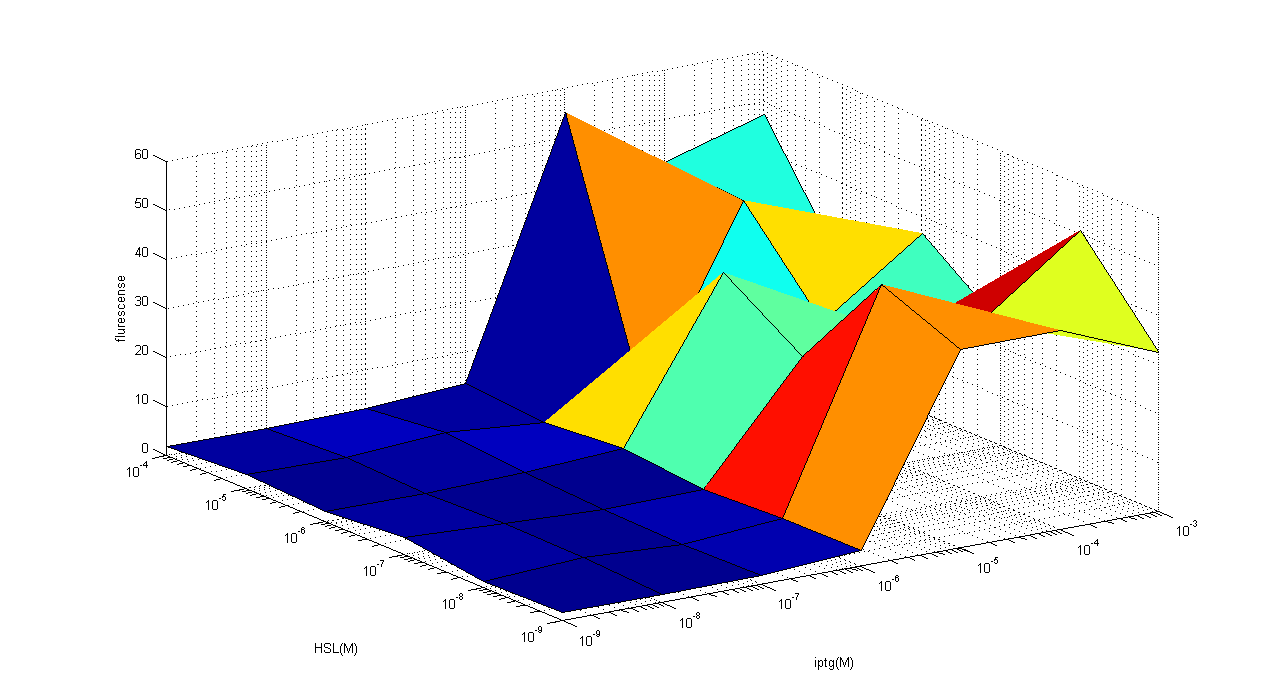 Fig4. GFP expression of AND gate, K228126 : lux-SupD-lac-T7ptag (rbs: B0033). The data are showed for (left to right): 1×10^-9, 1×10^-8, 1×10^-7, 1×10^-6, 1×10^-5 1×10^-4 and 1×10^-3M IPTG, and (bottom to top) 1×10^-9, 1×10^-8, 1×10^-7, 1×10^-6, 1×10^-5 and 1×10^-4M HSL.
Discussion:
From the result of some of these AND gates, we found that most of these AND Gates are always inducible by IPTG, but independent of the concentration of HSL. It indicates that the leakage of HSL sensor is significant, and the basal expression of SupD is so high that without HSL there is sufficient SupD to work on T7ptag. This result is consistent with the induction curve of HSL sensor.(there are quite amount of expression without HSL induction.)for more details, refer to Sensor Result.
Possible improvements:
Because the leakage is on the promoter which drives SupD, we can not modulate the RBS (there is no RBS on SupD side) to make a qualified AND gate. If the leakage is on the T7ptag side, we may get some good results after modulate its RBS (change RBS or mutate it). The best solution is to replace the HSL sensor with other better promoters. Actually we got some better results by doing this. They are Given below.
The result of other five AND gates are not shown here.
AND Gates of Shuke Wu
This AND Gate family is made of pLac-supD & pBad-T7ptag.
The typical pattern of this AND gate is similar to Shan Shen's AND gates.
This family is the AND gate family constructed also the quickliest: at the same time with Shan Shen's AND gates.
Nine AND gates sharing the same promoters and with the difference on the RBS of the T7ptag are in this family: K228823, K228824, K228825, K228826, K228827, K228828, K228829, K228830, and K228831. And these gates are also on the plasmid pSB4K5.
In order to test the function of these AND gates, Shuke use a reporter GFP under the control of a T7 promoter: K228099. And the reporter is on the plasmid J61002.
Using the E.coli with the reporter plasmid, he transformed the AND gate plasmids into it, and tested them using various combinations of different concentrations of IPTG and arabinose. The result is tested by a microplate reader (Fig 1, 2, 3 and 4. For more detail, refer to our protocol)
 Fig1. GFP expression of AND gate, K228829: lac-SupD-pBad-T7ptag(rbs: B0033). The data are showed for (left to right): 1×10^-9, 1×10^-7, 1×10^-6, 1×10^-5 1×10^-4 and 1×10^-3M IPTG, and (bottom to top) 1×10^-9, 1×10^-7, 1×10^-6, 1×10^-5, 1×10^-4 and 1×10^-3M arabinose.  Fig2. GFP expression of AND gate, K228827: lac-SupD-pBad-T7ptag(rbs: B0030). The data are showed for (left to right): 1×10^-9, 1×10^-7, 1×10^-6, 1×10^-5 1×10^-4 and 1×10^-3M IPTG, and (bottom to top) 1×10^-9, 1×10^-7, 1×10^-6, 1×10^-5, 1×10^-4 and 1×10^-3M arabinose.  Fig3. GFP expression of AND gate, K228823: lac-SupD-pBad-T7ptag(rbs: J44001). The data are showed for (left to right): 1×10^-9, 1×10^-8, 1×10^-7, 1×10^-6, 1×10^-5 1×10^-4, 1×10^-3 and 1×10^-2M IPTG, and (bottom to top) 1×10^-9, 1×10^-8, 1×10^-7, 1×10^-6, 1×10^-5, 1×10^-4, 1×10^-3 and 1×10^-2M arabinose. 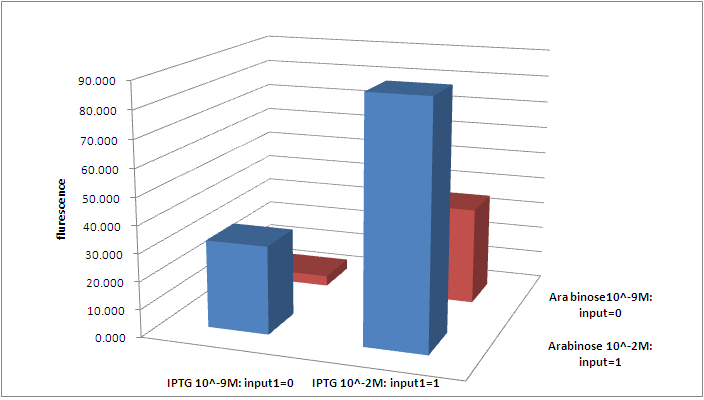 Fig4. GFP expression of AND gate, K228823: simplified version of Fig3. The data are showed for 1×10^-9 and 1×10^-2M IPTG, and 1×10^-9 and 1×10^-2M arabinose. The concentration of 1×10^-9 equals input=0, and 1×10^-2 equals input=1. So the four columns show the response of (0,0), (0,1), (1,0) and (1,1). Discussion: AND gate K228829 (Fig 1) and K228823 (Fig 3) are the two best AND gates in this family, while others did not display AND gate behavior (Fig 2). It is a common sense that the activity range of promoters affects the function of the AND gate circuit (Anderson JC, Voigt CA, Arkin AP (2007) Environmental signal integration by a modular AND gate. Mol Syst Biol 3: 133). Thus we used nine different RBSs as a method to modulate the expression level of T7ptag and got some quite good AND gates (Fig 1&3). However, this strategy can not change the transcription level of SupD, which may lead to leakage of AND gates. Because Shuke used lac system, which suffers from some problems (refer to our sensor result), to drive the SupD, this AND gate family can not have some perfect AND gates.
To improve, we should choose a tight promoter (pSal or pBad), with little leakage, to drive SupD.
The results of other six AND gates are not shown here.
AND Gate of Guosheng Zhang (The Best AND Gate we achieve)
This AND Gate family is made of AraC-supD & Sal-T7ptag.
There are nine AND gates in this family, and they are distinguished by the RBS of the T7ptag gene, while sharing the same promoters to drive T7ptag and SupD. They are , , , , , , , , and . And these AND Gates are on the plasmid backbone pSB4K5, which is low copy (about 5 copies) plasmid thus it facilitates further assembling.
What we showed here are two of the best AND gates which we obtained.
In order to test the function of these AND gates, Guosheng Zhang constructed a reporter GFP under the control of a T7 promoter, which will be activated if the T7 polymerase is successfully translated.(). And the reporter is on the plasmid .
The two plasmids are sequentially transformed to E.coli, a gradient of arabinose and a gradient of salicylate is combined to test the behavior of the AND Gate under different combination of arabinose and salicylate concentration. The result is read by a microplate reader. Data are processed and ploted using Origin. (Fig 1, 2, 3 and 4. For more detail, refer to our protocol)
 Fig 1. GFP expression of AND gate, K228260: AraC-SupD-Sal-T7ptag (rbs: J44001). The data are showed for (bottom to top): 1×10^-8M, 1×10^-7M, 1×10^-6M, 1×10^-5M, 1×10^-4M and 1×10^-3M salicylate, and (left to right) 1×10^-8M, 1×10^-7M, 1×10^-6M, 1×10^-5M, 1×10^-4M and 1×10^-3M arabinose. The Z axis denotes the value of fluorescence normalized by the OD600 value. |
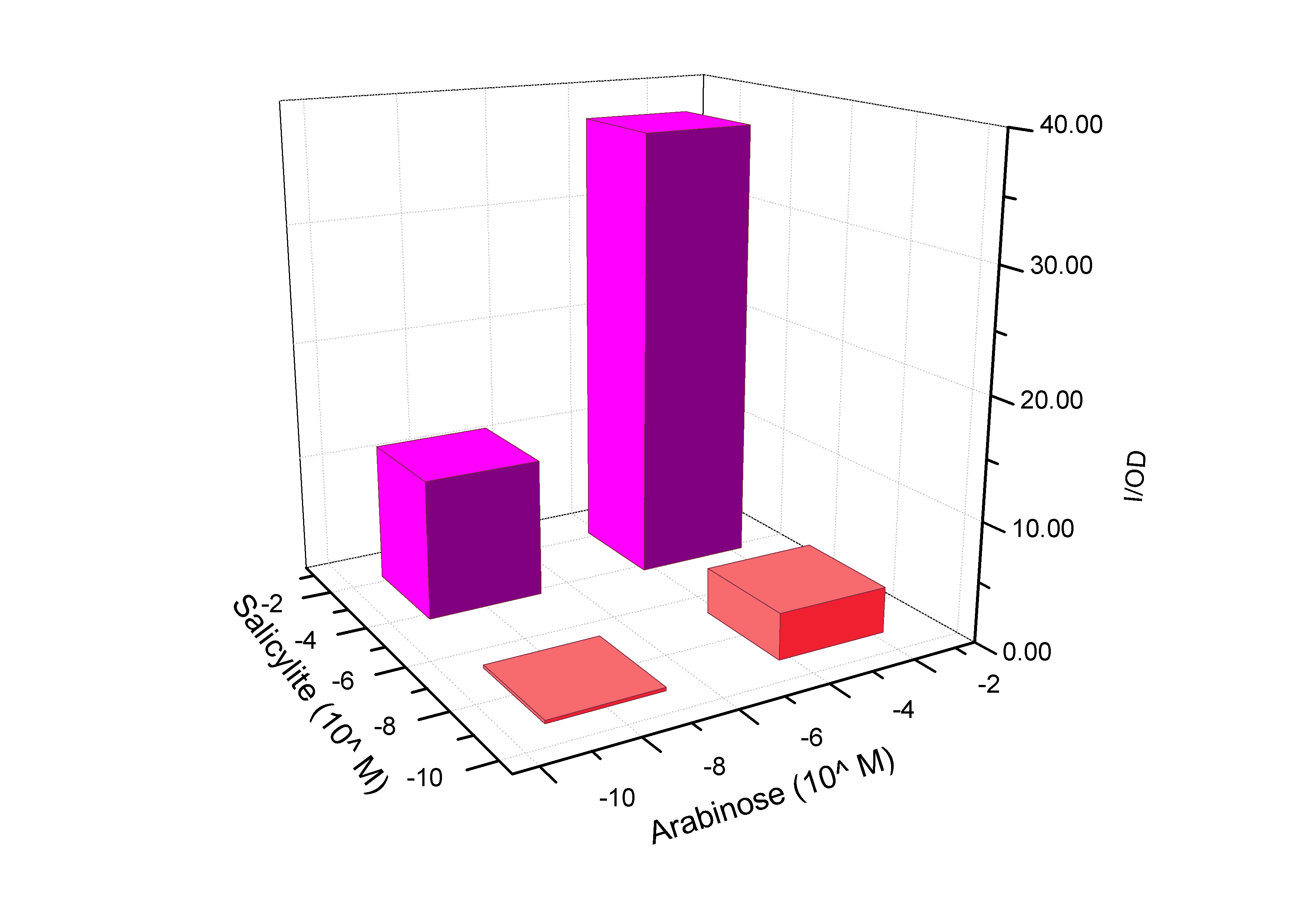 Fig 2. GFP expression of AND gate, K228260: simplified version of Fig2. The data are showed for 1×10^-8 and 1×10^-3M salicylate, and 1×10^-7 and 1×10^-3M arabinose. The concentration of 1×10^-7M is regarded as input=0, and 1×10^-3M is regarded as input=1. So the four columns show the response of (0,0), (0,1), (1,0) and (1,1). |
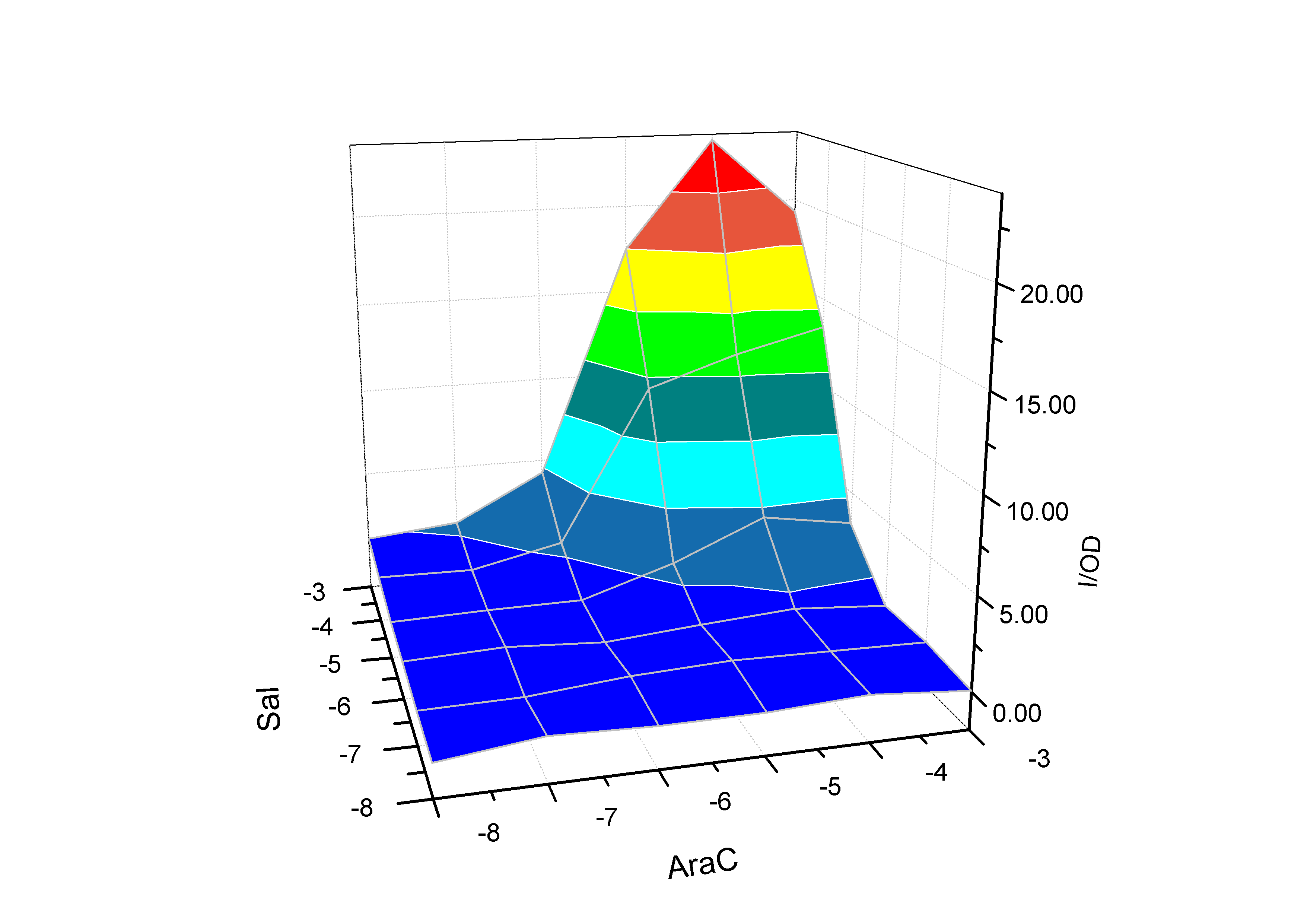 Fig 3. GFP expression of AND gate, K228260: AraC-SupD-Sal-T7ptag (rbs: J44001). The data are showed for (bottom to top): 1×10^-8M, 1×10^-7M, 1×10^-6M, 1×10^-5M, 1×10^-4M and 1×10^-3M salicylate, and (left to right) 1×10^-8M, 1×10^-7M, 1×10^-6M, 1×10^-5M, 1×10^-4M and 1×10^-3M arabinose. The Z axis denotes the value of fluorescence normalized by the OD600 value. |
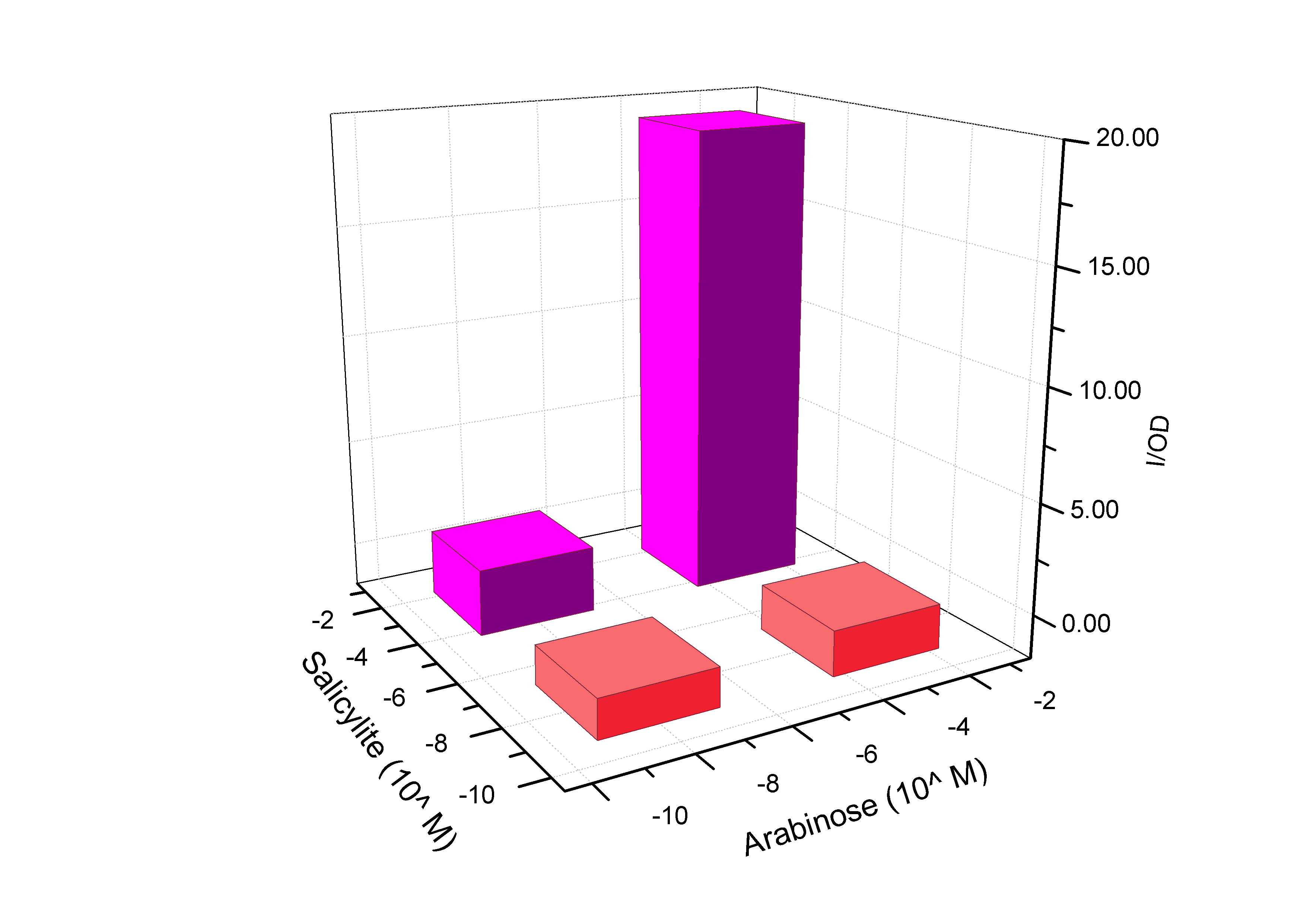 Fig 4. GFP expression of AND gate, K228260: simplified version of Fig2. The data are showed for 1×10^-8 and 1×10^-3M salicylate, and 1×10^-7 and 1×10^-3M arabinose. The concentration of 1×10^-7M is regarded as input=0, and 1×10^-3M is regarded as input=1. So the four columns show the response of (0,0), (0,1), (1,0) and (1,1). |
Discussion: It is a common sense that the activity range of promoters affects the function of the AND gate circuit (Anderson JC, Voigt CA, Arkin AP (2007) Environmental signal integration by a modular AND gate. Mol Syst Biol 3: 133). Thus we used nine different RBSs as a method to modulate the expression level of T7ptag. However, this strategy can not change the transcription level of SupD, which may lead to leakage of AND gates. Despite the little flaw, we still obtained some quite good AND gates. Obvious activation folds can be seen here as shown.
The results of other seven AND gates are not shown here.
Other AND Gates
All in all, we constructed 7 AND gate families, 63 different AND gates, by using 4 inducible promoters and 9 different RBSs. All of these AND gates are become standard parts, and we have tested most of them. The following is a list of these AND gates, and some information about them.
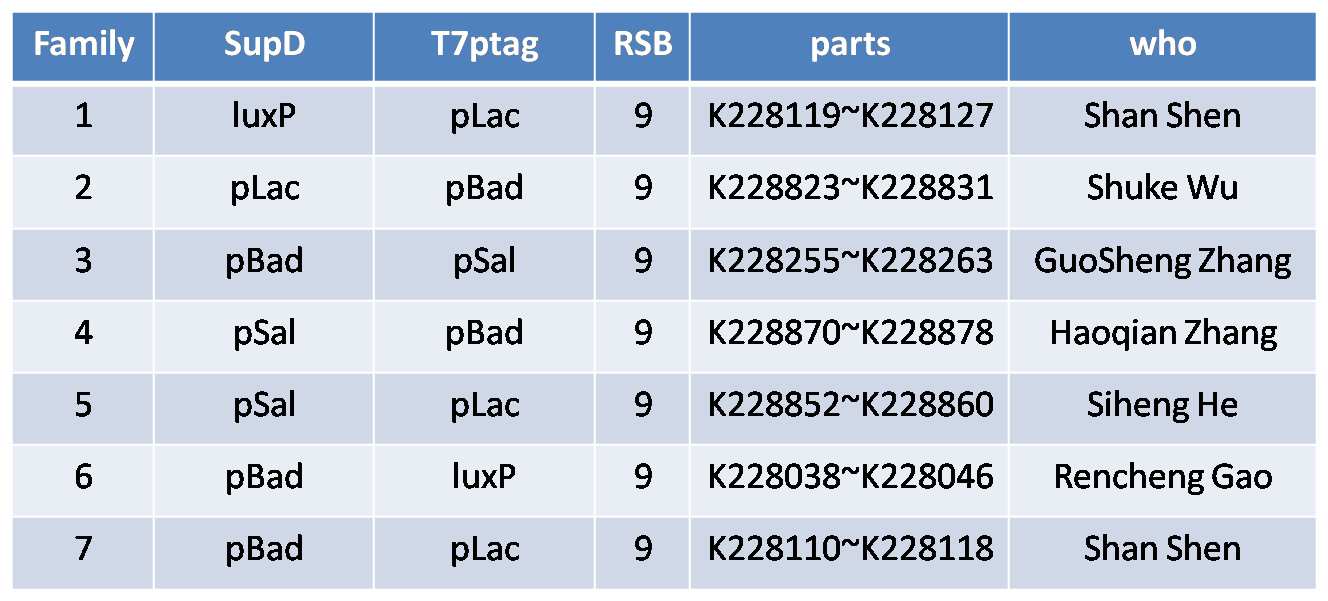 Table 1. All of AND gates we have constructed. SupD denotes the promoter drives SupD, T7ptag means the promoter drives T7ptag
^Top
|